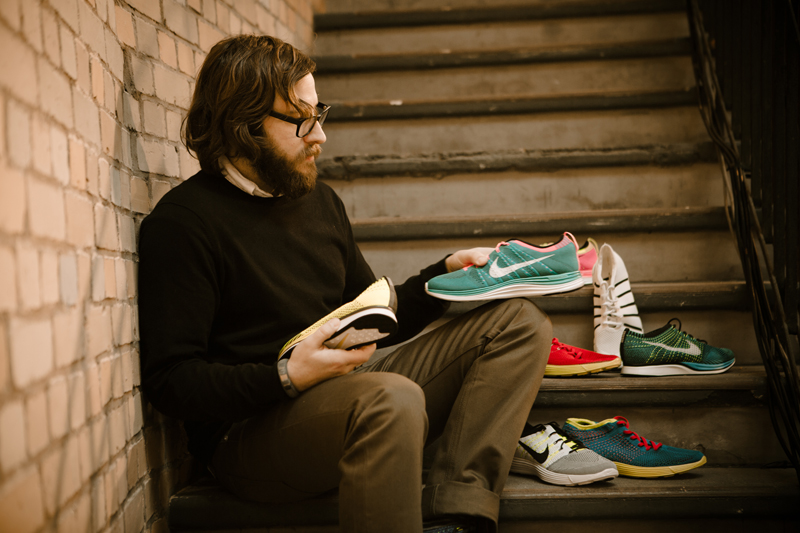Highsnobiety Interview –
Just last week, a former train station connecting Berlin to Dresden found itself converted into a neon-lit space for Nike’s aptly titled “Flyknit Experience” – a 1-night only event inviting both industry people and locals alike to lace up a fresh pair of Flyknit Lunar1s and run along an indoor track lined with giant disco balls. As if that weren’t enough, the Swoosh shipped over Jenny Sabin‘s dynamic installation consisting of data from Nike’s Fuelband arranged in a distinctly expressive and modern way.
After running a few laps and devouring one too many burgers, we sat down with Ben Shaffer, the man who with his team is largely responsible for Nike’s latest innovation, to discuss everything involved in bringing the revolutionary idea from inception to completion. Take a look below for the full interview.
You went from Head of Innovation at Nike Sportswear to Studio Director at the Innovation Kitchen, what were the two different roles like?
Within the Innovation Kitchen we at different times connect into other categories so for a while I was innovation leader for Sportswear which was pretty much acting as the liaison between the Kitchen on a number of projects. I worked on the Hyperfuse and getting that to Sportswear and about 2 years ago I switched over to Studio Director.
There’s a number of different directors in the Kitchen so I’m not running the entirety of the Kitchen, but basically it’s allowed me to focus on the design side of directing – creative directing – as well as still getting my hands dirty and working on projects such as Flyknit.
Were there any unexpected challenges when you first started working on Flyknit?
Yeah, plenty of challenges. Initially the whole focus was around trying to utilize knitting techniques to mimic what a sock would do for an athlete so the focus was around fit. We chatted it up with different athletes who described what was essentially using a sock in place of a shoe. It got a number of us thinking about ways within the industry we could actually start to mimic that and try to create the structure and durability that we would need in order to make an actual shoe out of it. That’s of course where we hit huge challenges because there wasn’t anything set up to do that for footwear.
So here we have an inherently dynamic material because it’s a bunch of loops of fabric/yarn that come together and we wanted to have areas where it didn’t stretch at all. So one of the huge hurdles was getting that structure in. At the time we were developing Flywire (which debuted back at the Beijing Olympics), and while we were developing that one we said well, we’re using yarn here, why can’t we just do some thicker braided cables with stronger yarn and find a way to have it channeled through the knit and have that knitted out?
We had a lot of play in that area about how we could embed and get cables throughout a knit fabric. Once we had that then all of a sudden we transitioned from having something that’s not just a nice knitted pattern, but something that’s really dynamic. This is because you’ve got static areas that don’t stretch at all but in-between you’ve got areas that can move. Having that really allowed us to dramatically adjust the function from one area of the shoe to another.
Flyknit is often referred to as a technology as opposed to just a new line of footwear, where else do you see the technology being used in the future? Can you imagine other practical uses for it?
Yeah absolutely. As a technology it’s an enabler for us to go after that unique fit, that unique experience within “right-now” running. Outside of just running product, we’re able to engineer at a much more detailed level and see which areas have various functionalities. There’s tons of benefits not only in other sports, but in other pieces.
Knitting in itself is a very simple thing, it’s been around for hundreds of thousands of years, and basically it’s going back and looking at it from the core of the material. By using knitting methods there’s a lot of opportunity out there to see what we can do.
It’s interesting too. Even at Nike, some of the things we’re doing within footwear is helping inspire apparel to rethink things. So there’s a fun back and forth which is one beautiful thing about just moving the needle anywhere. In any industry, when you start to pull knowledge from elsewhere and try to match things that aren’t necessarily meant to be together – a sock shoe for instance! It’s not something that you’d normally put together but the results are something really intriguing that have definitely changed how we’ve approached footwear. Of course you’ll be seeing a lot of interesting things coming out in the next few years.
Flyknit went through 195 major reiterations before arriving at the final product, do most new models go through that rigorous of a process?
Most new ones don’t, but we were developing so many different entities so as we went through round after round, we were learning what we could do, what type of yarns we needed, and what type of fabrics did certain things for us. Certain things didn’t feel right so we’d go back to the drawing board, or maybe tweak what we had, but all those different iterations were to gain knowledge.
Also, I think it’s important in design or for anything you’re doing that’s new to be iteration after iteration because in the end you’ll always make a much better product.
How did the construction method affect the color design process?
It dramatically affected it! You’re now playing with yarn that has one color and then you intertwine it with a different colored yarn and the textures are different in one area versus another so the visual starts to morph and do some amazing things. It certainly had us rethink what that means. When we think about all the things that can be done in the sweater world for instance, or just knitting in general, there’s so much potential, so it’s dramatically changed how we look at and do color, and it continues to amaze us the more we play with it.
Flyknits have made their way from the track and have become hot on the streets, is there anything in particular you attribute that to?
I think the uniqueness about Nike is that we make products for the athlete, for high-level performance; people often appreciate that and start to sport what is high performance in different contexts. A really good example of that is when you look at the car industry for instance, the one car you’re probably most aspirational towards, whatever that is, more than likely was designed to be a high-level performance product. So if we are smart to the core of that, some of these things will end up filtering through to street culture.
The Flyknit was named one of Time’s Best Inventions of 2012 in large part due to its innovative construction method, is there still room for improvement at this point?
There’s always plenty of room for improvement; we’re always very critical of ourselves and trying to move the needle at every point. There’s plenty of things I think we would do a little bit differently, now that we’ve had another year or two to dig deeper into the process. Building on this is what we do and that’s been Nike all along. We keep building, building, and building on our innovations and always assume there’s something we can improve on since nothing is ever perfect.
There’s a saying at Nike that there’s never a finish line and that saying really holds true. With innovation we’re constantly looking to do it better and bring out better products.
What’s been your favorite project to work on at Nike?
You know I have to admit I really liked working with Flyknit. It’s been a blast because it was just a couple of us a number of years back playing around and hoping this would turn into something unique. It’s been able to blossom and grow, and the uptake has been equally exciting from those that are elite-level runners to those that are a part of street culture. It’s really complimentary to that and it makes all the burdens and challenges so much more rewarding when we’re able to overcome them. So it’s definitely Flyknit for now.
When do you decide to pursue an idea that may at first seem far-fetched and when do you decide to scrap it?
Well there are plenty of ideas sitting around because it’s not the right time or the technology isn’t there yet. Whenever we start to get somewhere interesting, like putting a new shoe on a runner’s foot and hearing “this feels amazing,” then we know, we’ve got to go all in and make this happen.
It’s a tough moment because we are constantly debating that with a number of projects – is it right, is it relevant, is this the right time? Sometimes I’m sure we haven’t made the best decisions and things came out too early, but time will tell for us. We bring out stuff a lot of times that didn’t make it six years ago but now actually seem a lot more relevant. It’s amazing how things are constantly evolving depending on the manufacturing processes or just the culture or expectations and desires of runners and athletes. It’s a funny one, you never know exactly when it’s perfectly right.







